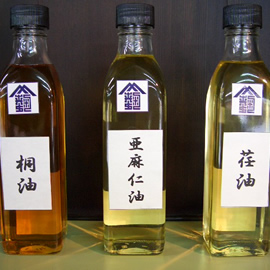Q: I have a question about how to coat a floor with oil. According to your website, various natural oils are suitable for wooden surfaces. Which oil is best suited to coating a natural cypress floor? How does the wood change depending on the oil used for coating?
 A: To coat a floor, we commonly use a drying oil like tung oil, linseed oil or perilla oil. These oils create a film on the wood’s surface that repels stains, and improves its imperviousness to water. Tung oil is brown and becomes transparent upon contact with the surface, so you can rest assured the wood’s color will stay intact. After some time it does turn slightly yellowish, but overall the color of tung oil is more or less stable. Linseed oil turns dark brown, and perilla oil will take on a light brown hue with time.
A: To coat a floor, we commonly use a drying oil like tung oil, linseed oil or perilla oil. These oils create a film on the wood’s surface that repels stains, and improves its imperviousness to water. Tung oil is brown and becomes transparent upon contact with the surface, so you can rest assured the wood’s color will stay intact. After some time it does turn slightly yellowish, but overall the color of tung oil is more or less stable. Linseed oil turns dark brown, and perilla oil will take on a light brown hue with time.

The oil best-suited to Kyoto’s traditional townhouses is undoubtedly perilla seed oil. The most viscous of these oils is tung oil, the second being perilla seed oil, followed by linseed oil. In winter, drying-oil increases in viscosity and tung oil in particular becomes harder to spread. All natural oils have their unique smell. Tung oil is one with an especially pungent odour; the second most potent is perilla seed oil and the third linseed oil. There does not seem to be a remarkable difference in how fast the smell dissipates among these oils, we hope to do more detailed research on this in the future.

